Summer has officially arrived in all its glory – with high temperatures, sunshine days, hot nights, pool relaxing, and ocean exploring. But besides those classic activities, summer crept into every home too!
From lighter decor based on different shades of blue and white (colors of the sea are certainly the most popular ones during these months!) to the simple details of boats, fishes, stones, and sand, summer has officially turned our lives upside down. And I love it! Everyone can easily and simply make a beautiful decor transition so those days before your vacation are spent in a breathtaking oasis of your own home. But besides those classic tips and tricks, have you ever thought of taking a bit different road? Perhaps a road which is less traveled? Hang in there, I’ll let you know exactly what I’m talking about!
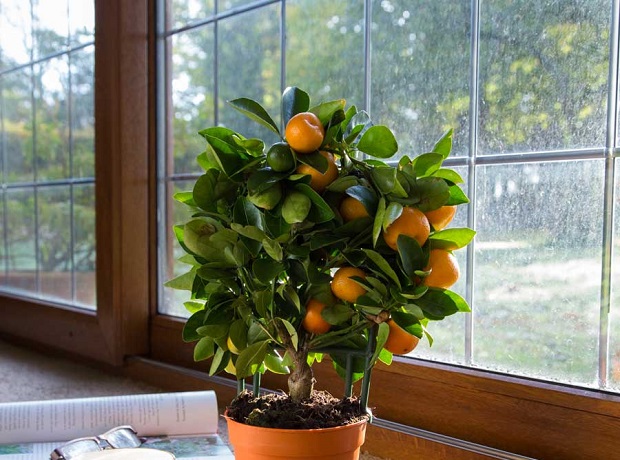

Besides making your home a beach oasis with a nice color palette and all those sea details, I have an idea for the breathtaking centerpiece which is not only the most beautiful centerpiece decor you’ll ever see but also a healthy snack or a basic ingredient for light and delicious summer recipes. Have you ever thought of a summer fruit tree that is not only tasty but aesthetic too? Well, I have, and I’m bringing you ideas, as well as tips and tricks on how to choose, grow, and enjoy these beautiful summer centerpieces made of simply – naturally grown plants!
You’re wondering which tree is a perfect match with your home decor? I’m bringing you all the answers!
Splendor Of The Summer Fruits
Some of the basic summer fruits are apples, apricots, avocados, bananas, watermelons, strawberries, plums, grapes, pineapples, and more. And some of those fruits have their mini versions which are simple to grow in a decorative pot and then presented as an unusual, beautiful, and unique summer centerpiece.
Since every season has something different in focus, this time, I’m putting mini fruit trees in that spot. They are small and due to that, suitable to be put on the table, they come in different shapes, colors, and textures, with interesting leaves that contribute to the tree’s beauty.
Due to their shape, coloring, and greens, every home design is suitable for a different type of this summer centerpieces – from rustic, vintage, and industrial, to those homes with modern touches, innovative architecture lines, and creative textures of the shapes.


Now, in the design world, there are a couple of the basic rules that should help you choose the best centerpiece for your dinner date, family gathering, or friends’ get-together. For example, you can choose contrast colors to make the details stand out or the interesting shape of a tree which will nicely contribute to the entire design. You can choose fruit that beautifully complements the rest of the plants and flowers or just go according to some other details, their colors, lines, and textures. But despite all the rules you may or may not heard in the last couple of years (or the ones which present new trends every other season), the most important part is to choose a fruit tree which comes with that specific impression – you know how sometimes you look at some decor and you immediately know which style it presents? Well, that’s how you choose every centerpiece, not only the fruit tree!
So basically, the rules can be changed according to your preferences and wishes, as well as the impression that a certain type of fruit tree leaves on you. But let’s go into details, fruits, colors, and shapes – that’s the best way to find your perfect match!
Orange
The mini orange tree comes with a beautiful palette of colors. It combines light brown wood with long green leaves of different sizes, and small, round fruit in specific orange coloring perfect for lighting up the entire indoor space. Depending on the growing period and method, orange can have one or a couple of more main and strong branches. The trunk of the tree is a bit naked since the canopy (known as the crown) is higher in the air, but that combination works in quite beautiful harmony.
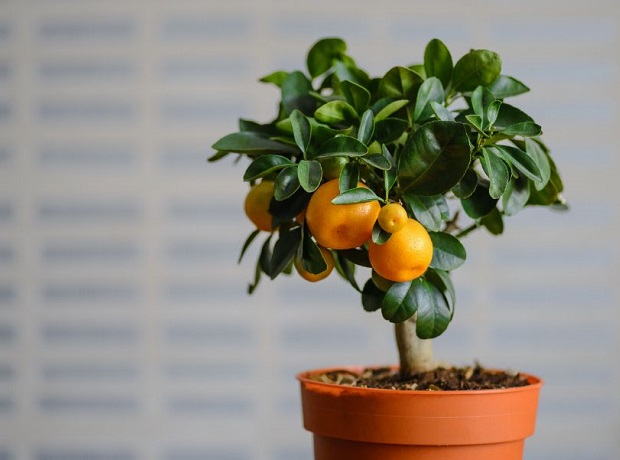

The miniature oranges can be eaten but they have a slightly bitter taste than the usual oranges. Due to that, they are beautiful as a decorative pieces, but when it comes to their taste, they certainly not everyone’s cup of tea. Besides the taste, the mini orange tree has a classic and seductive fragrance that will certainly bring a touch of the Mediterranean into your home.
How To Care
Mini orange tree needs up to 12 hours of bright sunlight per day, but make sure it is shaded from too much sun during the summer. The ideal temperature is around 68° F and when it comes to watering, this procedure needs to be frequent. There are no rules, just adjust the amount of the water to the individual tree, as well as to the growing conditions. The mini orange tree also needs regular application of citrus fertilizer.
Suitable Home Design
The mini orange tree is perfect for a minimalistic home. If you love those light colors such as white, beige, and a similar color palette, the mini orange tree is perfect to bring color and a bit of texture into such shades, especially if you have that amazing massive table. To get the most of its decorative beauty, put the tree into an interesting vase (but don’t choose the one that has too many details). Maybe simple design but a bit darker shades of brown or you can get a transparent glass vase so the color of the soil will give that interesting touch.


For the table decor, keep it simple – lighter colors of the plates, interesting design of the glasses, and a bit darker shades of the napkins. Try to combine them with the vase and play with different brown shades.
Lemon
I love yellow touches in every space – they bring light, sunshine, and a touch of true color into every home! And besides yellow pillows, blankets, frames, magazines, and flowers (equally divided in the house, of course), the lemon tree can surely give that special touch too. The lemon’s main branch is thin and naked but its canopy is long, elegant, and beautiful. The leaves vary in different sizes but thanks to that, they bring interesting textures to the canopy. Green touches of the leaves beautifully harmonize with yellow balls of lemon.
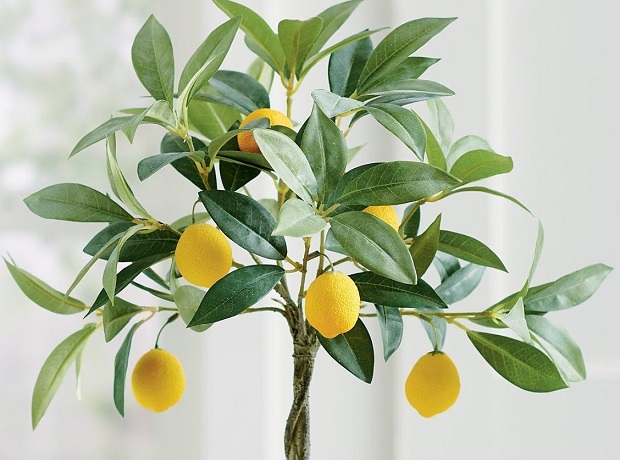

Despite its size, the mini lemon tree (known as dwarf lemon too) produces full-size fruits and they have the same flavors and aromas as any other classic-size lemon tree. The lemon also has sweet-smelling flowers with a touch of classic lemons’ aromas. Quite a nice summer fragrance if you ask me!
How To Care
The most critical factors for growing (successfully) lemon tree is the light and temperature. The tree should have up to 8 hours of sunlight every day. The rule is actually quite simple for the lemon – the more light it gets, the better the results will be. When it comes to the temperature, the most suitable one is around 65° F. Since the lemon tree won’t tolerate cold or hot drafts, make sure to place it away from heating ducts and air conditioning. Your lemon tree will be thankful! Oh, and since the summer is here, you can move your lemon tree outdoors for extra sunlight. The lemon tree should be watered once the soil is dry out about 3 inches deep. Make sure to give it essential nutrients too.
Suitable Home Design
The lemon tree is great for lighter shades or rustic lines, just make sure to pick a suitable vase. If you want to place the tree in a minimalistic space, choose a simple vase with smooth lines and design. The coloring can be in any shade of brown or even in the lighter yellow shades, but make sure to let the fruits be the main pop of color. You can combine the table details in similar colors, especially in the brown nuances and nude shades.
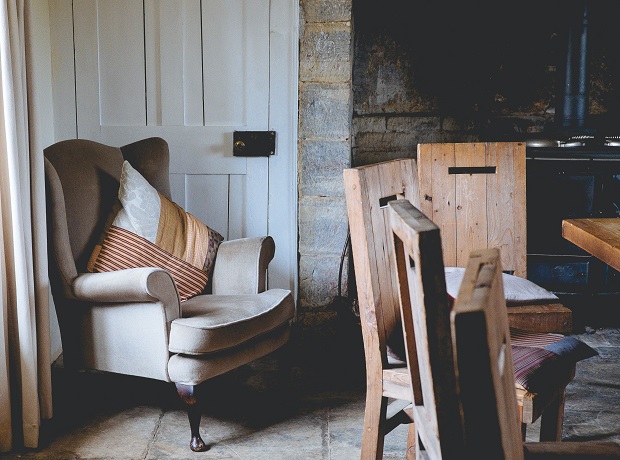

If you have rustic decor, put the lemon in an interesting vase – a wooden vase or textured basket, grey, almost industrial design, or some other rustic version. The lemon is elegant but its rustic vase will beautifully combine with the fruit, as well as the surrounding space and its lines and details. The decor of the table should be minimalistic then but with darker plates which will perfectly complement the space.
Key Lime
Dwarf key lime combines a beautiful palette of green nuances – both its leaves and its fruits are in green colors, so the tree comes with an aesthetic combination of lighter and darker green shades. Depending on the growing method, the key lime tree can be shaped in a small bush or it can have a small, a bit naked branch with a lavish canopy.


The leaves of the tree are long and they grow in nice darker green color, while its small and rounded fruits have a bit lighter color which certainly contributes to the fullness of the canopy. The spindling branches of the tree are covered with thorns, while its aromatic white flowers bloom, and when pollinated, they turn into small limes with sweet-tart flavors. Your home will smell amazing during these hot summer days!
How To Care
Dwarf key lime tree needs to have evenly moist soil but not too soggy. If the soil is constantly wet, the tree’s roots may rot. So the basic watering advice is to water the soil thoroughly to wet all the roots. The second watering should be once the top 2 inches of the soil are dry out. Place the key lime tree in a sunny place. You can place the tree outdoors during the summer so the bees take care of pollination.
Suitable Home Design
Since the dwarf key lime tree combines a bushy canopy with beautiful green shades and palette, this tree is perfect for the vintage, industrial, and rustic home interiors. It will give your home a bit of freshness and edginess since it combines darker colors and shades. Besides that, the bush will definitely add interesting texture too! But in order to be a perfect and effective centerpiece, make sure that space isn’t too much filled with details, different coloring, and shades. The tree will do its part!
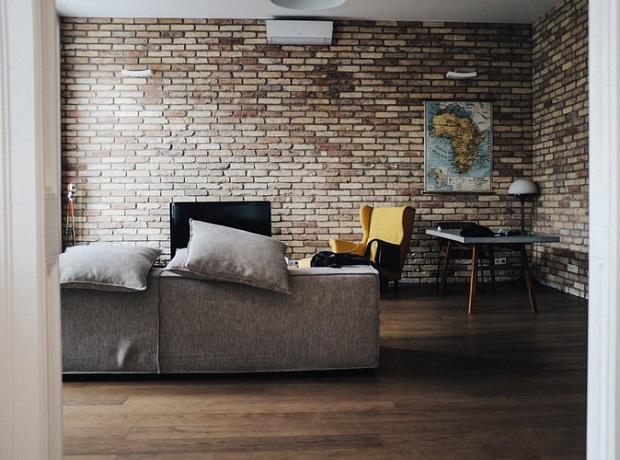

When it comes to the table decor, stay within your home style – you can definitely use a bit edgier pieces, darker colored plates (brown, black, dark grey, dark blue), and interesting designed glasses. To bring harmony and balance, you can use lighter napkins.
Tangerine
The dwarf tangerine tree is a mandarin orange hybrid. It is a small bushy tree that combines densely lined dark green leaves interviewed with round fruits in orange color. Since not all fruits are in full bloom at the same time, the tree beautifully combines orange fruits with smaller balls of green and yellowish touches.


Tangerines are quite smaller and less rounded than classic oranges and their taste is sweeter and a bit stronger. The fruit has a dozen small seeds too. Since this tangerine certainly presents a classic citrus tree, it will give your home a fresh scent with a touch of sweetness!
How To Care
The dwarf tangerine tree needs a lot of sunlight so make sure to place it near a sunny window. During warm months, the tree can also be placed outdoors to get even more sunlight! The best average room temperature should be between 65-75°F and make sure to give the tree slow-release plant food during the growing seasons. When it comes to watering, just allow the surface of the soil to dry before any action.
Suitable Home Design
The tangerine tree is perfect for rustic decor! You can definitely place it in a rustic vase too – a simple design in rustic shades of brown will be effective, yet it will give the fruits to stand out with their orange color. Dark green leaves will also be complemented with such a vase. Since the tree is bushy with a beautiful color palette, it will give freshness to your interior while its texture will make your rustic design pop up even more!


As a centerpiece, the dwarf tangerine tree will certainly be the light of the party – it will give a touch of colors to the table, especially if you keep that earth coloring tones in the details such as the tablecloth, napkins, and tables. You can definitely combine glasses with a textured design, while the cutlery should be kept simple.
Banana
The dwarf banana tree is quite elegant with its long and beautiful leaves. Its main branch is strong and combines brown and green shades. The fruits vary from the light green and yellowish combination to classic bright yellow coloring with just a small touch of green nuances. The banana tree comes with beautifully divided leaves that are directed upwards.
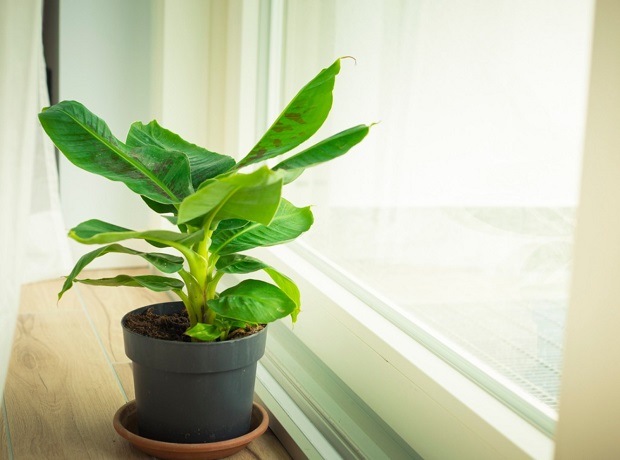

Some types of dwarf banana trees produce edible fruits while others produce fruit you can’t really eat but still, they are quite aesthetic and they certainly look beautiful among those elegant and glamorous leaves.
How To Care
The dwarf banana tree needs full sun up to 4 to 6 hours per day so place it in a south-facing window where the tree will get the most light. The room temperature perfect for the tree is 67-80°F. When it comes to watering, the tree must be 25 to 50% dry before the next watering. Water it thoroughly so the water flow nicely, but don’t water it too much – if the tree’s roots sit in water, they will rot! The dwarf banana tree needs diluted liquid fertilizer once a month. Since bananas are known for their quick growth, this monthly food will help sustain that growth.
Suitable Home Design
This elegant dwarf banana tree has beautiful broad paddle-shaped leaves which bring elegant and glamourous touch to any home interior. But the most perfect space is surely designed with modern lines and minimalistic texture. Put the tree in a classic and simple ceramic vase in a bit lighter color so the leaves can be in the center of the decor. Even though the dwarf banana tree is, of course, smaller, it can fit as a centerpiece only in its earlier growth stage. Afterward, the tree does get a bit too big for that role.


The banana tree is quite glamourous and due to that, perfect for a bit fancier dinner nights. Keep the elegance in the table decor too – simple but elegant lines of the design, white touches, and details, and simply designed and tall glasses will certainly contribute to the elegance of the decor!
Mulberry
This is a quite specific tree – it has a bushy canopy with beautiful small leaves. The leaves are a bit wild and due to that perfect for adding texture to your home. The tree has small red and black fruits scattered through the leafy bush. Each fruit has a small bubbly texture which brings special aesthetic touch to the entire tree. Besides, all the shades of the green canopy and the fruits look amazing together.
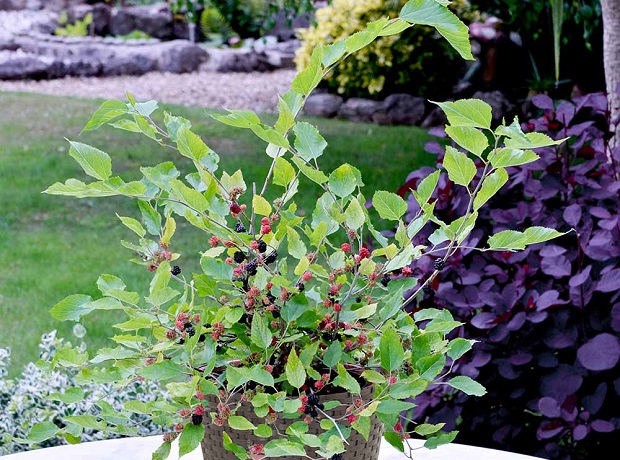

When it comes to the taste, the fruits can be eaten once they are riped. They have a combined flavor of the blackberries with their own specific nuances. The mulberry tree will bring warm, earthy, and sweet fragrance, quite perfect for the summer!
How To Care
The dwarf mulberry tree is really easy to take care of. It just needs full sun exposure and water. Since it is often referred to as a quite forgiving plant, it will do okay both with wet roots and a bit of drought – the tree needs little care but it will certainly easily adapt to the surrounding conditions.
Suitable Home Design
Since the dwarf mulberry tree looks a bit wild, its messy and bushy canopy will look beautiful in rustic and vintage surroundings. Put the tree in a simple vase that has a bit lighter brown or beige shade. It can be a bit rustic too – washed details or coloring would be perfect in the combination with the tree’s wildness!
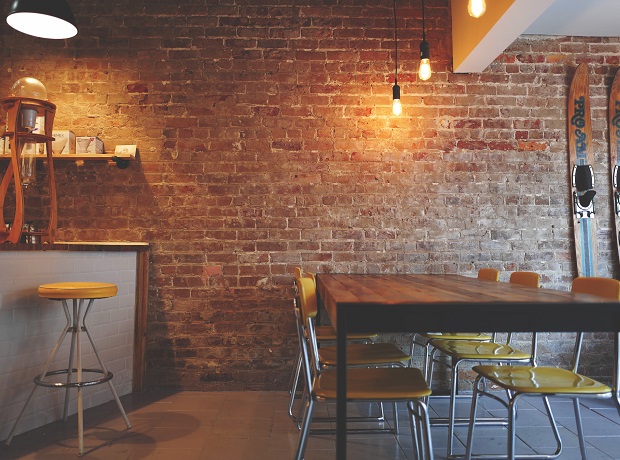

As a centerpiece of the table, the mulberry tree is perfect in the combination with the already mentioned earthy tones such as brown and beige. Since the tree has touches of red and black in the combination of green shades, you can go with that lighter earthy palette which will create a beautiful harmony with the tree which will still be the focus of the entire table decor.
Olive
The olive tree is a perfect centerpiece decor for years now. It has a thin main branch with a lot of smaller ones, while its elegant, long, and small-in-size leaves bring that sophisticated touch, elegance, and beautiful shades of green. The fruits of the tree are small and a bit oblong, while their color varies from green to darker purple, almost black shades.
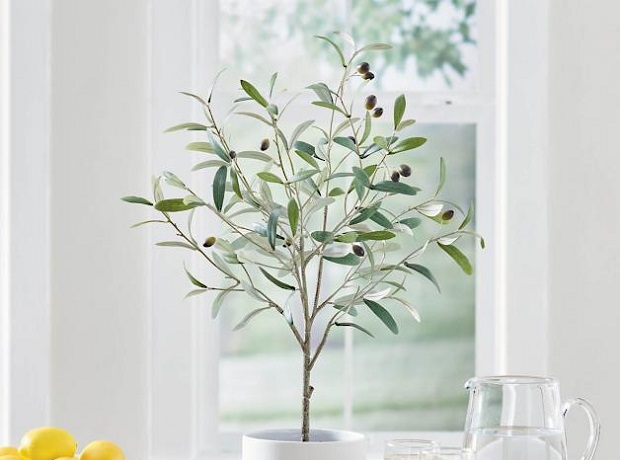

The olive tree is certainly known for its branchiness and longevity, while its scent is quite unique and characteristic – it simply comes with the scents of the sea and Mediterranean sun. Due to that, this beautiful tree will bring the sun, sea, and all other factors which will contribute to the beauty of your home, as well as bring the classic aromas of the summer.
How To Care
The olive tree needs full sun for at least 6 hours a day. It is best to place it beside a sunny, south-facing window. The olive tree needs to be watered once the top inch of the soil is dried out, especially during the summer. Once the fall and winter come, the tree needs less water because it takes a natural rest. Besides that, the tree needs to be fed once a month when those seasons kick in so use a balanced houseplant fertilizer.
Suitable Home Design
Due to its beauty and elegance, yet its wild branchiness, the olive tree is a perfect match for most of the home decors. It looks great in minimalistic spaces where the white color is the main color, it brings a touch of wildness into rustic homes, while it looks amazing in modern interiors where it brings a bit of texture. In order for the olive tree to fit those spaces, just make sure that its vase complements the design lines of the interior and you’re good!
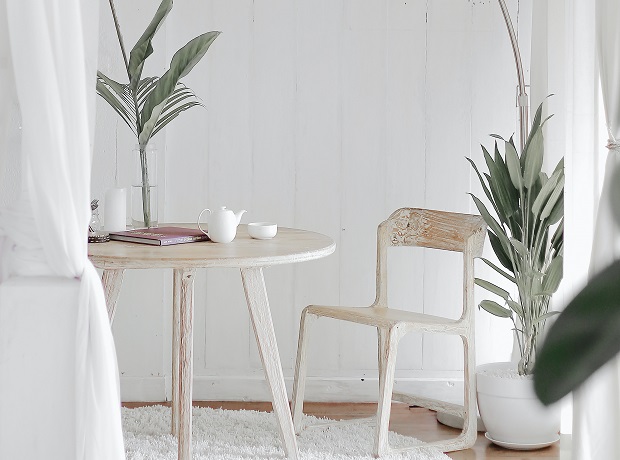

The same rule goes for table decor. If you want to use an olive tree as a centerpiece (and you definitely should!), make sure to choose suitable decor and color palette according to the surrounding design and according to the vase. Olive oil is really easy to adapt to almost every home design and table decor so it will surely be an outstanding centerpiece in the combination with different colors, shades, and nuances, while it will bring a beautiful texture and earthy touches!
Short (But Important) Guide
Okay, try to say that you’re not interested or not in love with all those mini fruit trees with a role of an amazing centerpiece! They are simply beautiful and thanks to all of their colors, textures, and lines of growth, each of them is perfect for a specific home design. And yes, these small trees certainly make your home and table pop up.
In order to choose the best centerpiece tree for your home, here is a guide with a couple of tips and tricks which will help you choose and grow your new live decor!
Suitable Surrounding Conditions – first things first, do research and find out everything you can about the suitable surrounding that the fruit needs. Does it need a specific temperature? Does it need full sun exposure? Or perhaps a specific amount of time on the sun? Can you fulfill such and similar factors in order to provide your fruit tree a perfect growing surrounding and conditions?
Care & Watering – before you get a fruit tree suitable for indoors, make sure to research and learn about how to take care of it – does the tree need a specific soil after some time, what about additional food, how often it needs to be watered, and more. Learn about the fruit tree before you get one!
Suitable Home Design – okay, we talked about this part in every fruit tree paragraph, but I want to talk about it again. So, I recommended home design and decor for every mini fruit tree but you can always go with some other combination, some different design, and different decor. You know how? Just make the vase suitable for your home style. The vase can certainly change the tree’s vibes and due to that, you can make it suitable for every style – from rustic and industrial to vintage, modern, and minimalistic. Once you choose the perfect vase, it will surely complement the space, as well as the table, while your mini fruit tree will still be a perfect centerpiece with pop-up touches!
And that’s it! That’s all you need to know before getting a beautiful mini fruit tree which will be a truly breathtaking centerpiece. Play with the table decor, don’t forget the details, explore different colors, palettes, and shades, make the tree brings a texture and that wow effect, and let it connect all the dots of your table – quite a perfect summer scene, isn’t it?
Sources Used:
- smartgardenguide.com
- pennington.com
- dengarden.com
- guide-to-houseplants.com
- food52.com
- gardeningknowhow.com














Leave a Reply